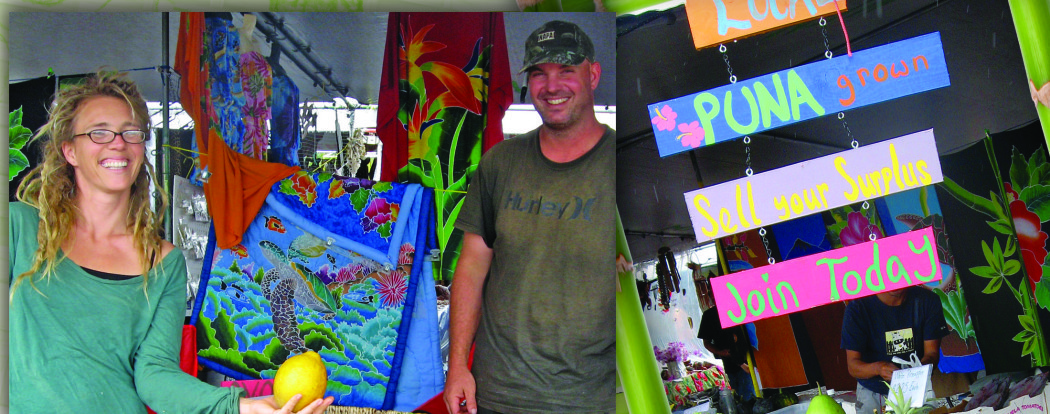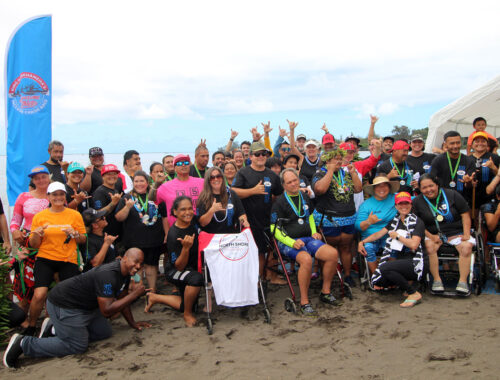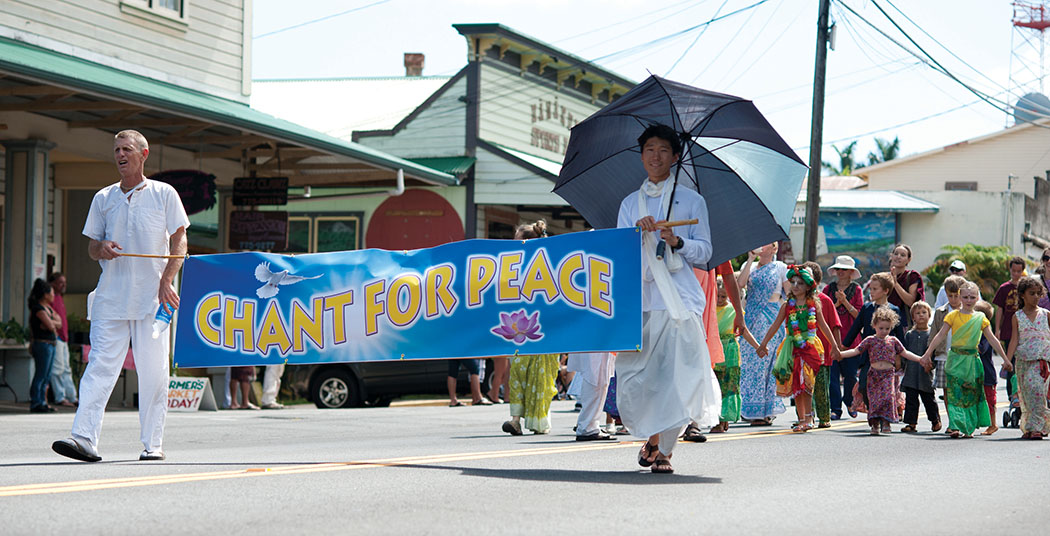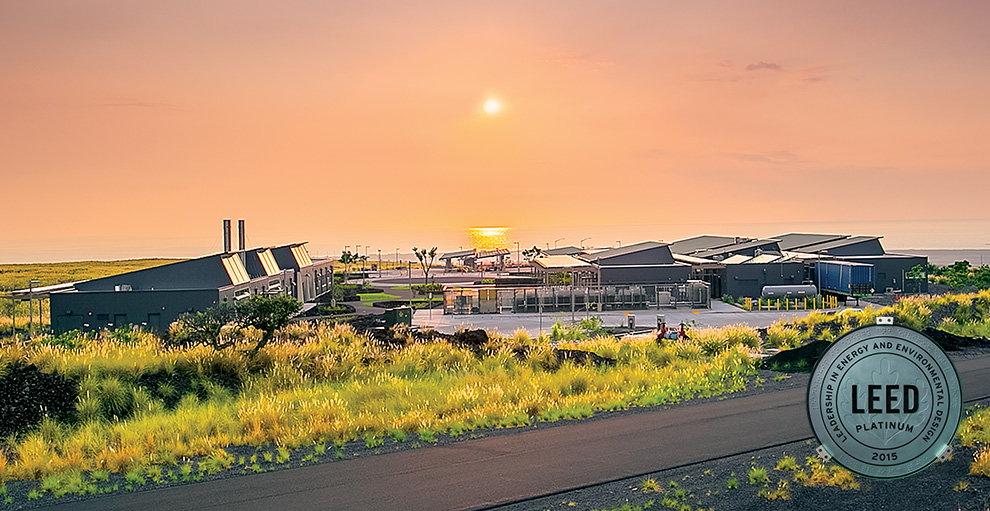
LEED-Certified: Pālamanui Offers 21st-Century Learning

By Fern Gavelek
Imagine going to college in a learning laboratory where sustainable building and design has earned the highest award in the green building industry.
Residents of West Hawai‘i can do just that at Hawai‘i Community College, Pālamanui and University of Hawai‘i Center, West Hawai‘i.
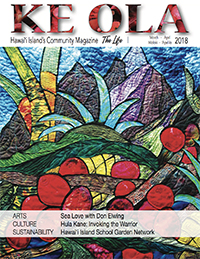
Located in North Kona, just mauka (mountain-side) of the Ellison Onizuka Kona International Airport at Keāhole, HCC-Pālamanui boasts a Platinum rating for Leadership in Energy Environmental Design (LEED) from the U.S. Green Building Council. Platinum is the highest rating possible in the sustainable building program.
Completed in time for the Fall 2015 semester, the $27 million first phase of the campus provides 24,000 square feet of instruction space, including classrooms, offices, library, culinary arts kitchens, and science labs. Today, it’s where more than 500 students are enrolled in a variety of academic disciplines: liberal arts, digital media, hospitality, tourism, nursing, and more.
The campus earned LEED’s top rating by incorporating numerous sustainable elements into its design and construction: on-site photovoltaics (PV) for electricity, efficient water and natural lighting systems, a wastewater recycling system, and sourcing of sustainable building materials.
Honolulu-based architecture firm Urban Works designed the campus and it also won a Renaissance Building & Remodeling Grant Award in 2016 from the Building Industry Association of Hawai‘i. Pālamanui is heralded for being a learning laboratory that demonstrates off-grid constructed wetlands, passive solar orientation, and a PV array.
LEED is considered the most widely used green building rating system in the world. According to leed.usgbc.org, LEED offers independent verification of a building or neighborhood’s green features, evaluating design, construction, operation, and maintenance of resource-efficient and cost-effective buildings. Based on the number of points achieved, a project earns one of four LEED rating levels: Certified, Silver, Gold, and Platinum.
According to the LEED Case Study brochure for the campus, Pālamanui illustrates the benefits of green building design as shown in the following projected statistics:
- 45% indoor water savings or 71,590 gallons/year
- 30% energy cost savings or $101,316 in electricity saved/year
- 100% gray and black water reused for irrigation or 394,642 gallons/year
- 40% energy produced by PV on site or $103,904 in electricity generated/year
Pālamanui Director Dr. Marty Fletcher says a dashboard is in the works to share live data on the green building operating systems of the campus.
“We’re looking at both a touch screen and online portal to show the numbers in real time,” explains Marty. “This information can be used by students to calculate sustainability problems and outcomes.”
Using the data, for example, a student could come up with a recommendation to reprogram the timing of air conditioning, taking into account real weather conditions.
“The statistics on our power and water usages could be used to provide sustainable solutions to students working on assignments in math, science, and Hawai‘i lifestyle classes,” notes Dr. Fletcher.
Going Green—A Goal that Inspired Campus Fruition
The Pālamanui campus was envisioned and designed as a learning laboratory, and as a sustainably-built campus. According to Beth Sanders, who served as interim director of the University of Hawai‘i Center-West Hawai‘i at the former Kealakekua campus, the idea of having a green campus took hold during planning sessions in 2007.
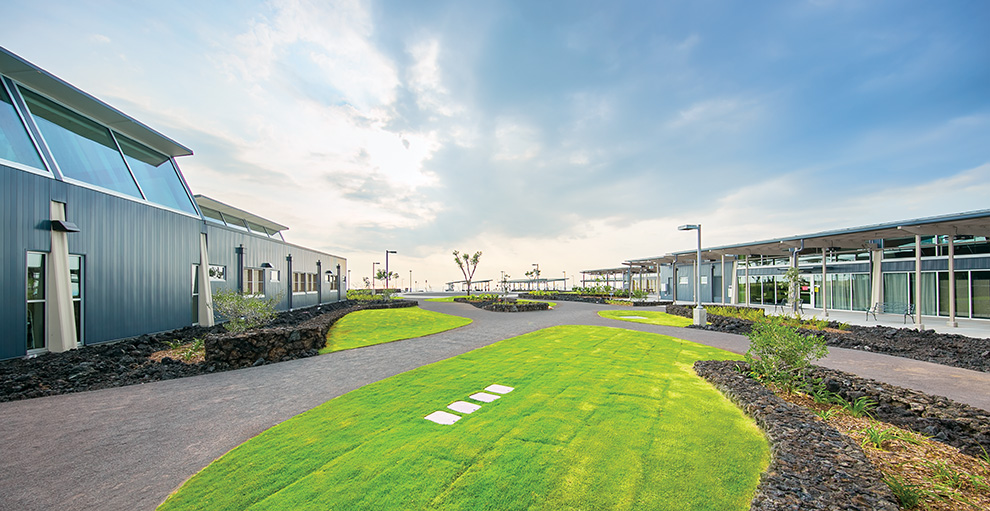
“We, in administration, had a vision to have a sustainable campus and so that focus became part of the conversation,” she shares. “Sustainable building was a new idea in Hawai‘i then and it provided inspiration to set us apart from others. We really pushed for that goal and it helped us succeed in bringing the new campus to fruition.”
At Pālamanui, Beth is an accounting professor who also serves as the lead faculty liaison between Pālamanui and HCC-Hilo. She adds that thinking sustainably, in the context of Hawaiian culture, is important.
“We wanted to set an example on how to take care of and honor our island home,” Beth details. “As a community college, I think we’re supposed to be initiators and think sustainably.”
Building the Campus
The 73-acre Pālamanui site provided Urban Works with a variety of challenges. An undeveloped lava field, the location was isolated from existing infrastructure and included an archaeological preserve containing burial sites and culturally significant features. It was determined to include sunlight harvesting through a photovoltaic system, daylight harvesting, mixed-mode air conditioning and natural ventilation, an onsite wastewater system, and water recycling for irrigation.
The site’s large archeological preserve influenced building placement and offered cultural educational opportunities. Buildings were positioned to also ensure preservation of views to Maunakea and the ocean. Since the campus sits in a vast, undeveloped lava field, it appears to “float” above the pahoehoe (lava) landscape.
“The project reduced cut-and-fill to minimize impact and tread softly on the land,” explains Karen Lee, senior associate at Urban Works. “Site disturbance during construction was limited to only 10 feet beyond the edge of the sidewalks/parking lot and 40 feet beyond the edge of the buildings…the lava field comes right up to the buildings.”

The entire campus is also situated to maximize solar exposure. PV panels cover south-facing roofs and extend over exterior corridors and outdoor classrooms. On muggy days, buildings use a high-efficiency, VRF-zoned cooling system. Providing precise, zoned control of an area, VRF is an energy-efficient HVAC system used in schools. Shared spaces are paired with signals that indicate optimum conditions for natural ventilation. If windows are opened, the A/C shuts down and fans kick in to circulate air.
Classrooms and offices rely on horizontal surfaces, called lightshelves, to reflect daylight deep into interior rooms. Combined with strategically placed glazing, the effort gives all classrooms and gathering spaces ample natural daylight, plus views to the outdoors. Paints, carpets, and other indoor materials are low-emitting, rendering optimum indoor air quality.
Chosen for durability and environmental stewardship, building materials included local aggregate, polished concrete floors and FSC sustainably certified wood beams. FSC building materials are sourced from responsibly managed forests that provide environmental, social, and economic benefits.
“We used glue-laminated timber structures rather than steel,” elaborates Marty. “A lot of energy is used to produce steel.”
Water isn’t wasted at Pālamanui, the only UH campus to boast an onsite wastewater treatment system. It employs constructed wetlands and recirculating sand filter technologies to treat 100 percent of its wastewater from buildings, which is reused in the native landscape. Stormwater is managed by surface swaling to irrigate xeric (dry-tolerant) landscaping.

Showers are available for cyclists, as the campus is bike and pedestrian friendly. Pālamanui sits on the northernmost end of the under-construction Queensʻ Lei, a 16.7-mile looped pathway for cyclists and pedestrians connecting to Kailua Village. In an effort to encourage the use of mass transit, the Hele-On Bus stops at the campus Monday through Friday. Preferred parking spots are reserved for low-emitting vehicles and those who carpool.
Across from the parking area is the landscaped gateway to the campus, considered the campus piko or umbilical cord, which is inspired by traditional Polynesian gathering spaces. Situated under a triangle-shaped canopy, Dr. Fletcher says the spot can accommodate 500 people during commencement and is the location for the UH Speaker Series. A campus hub, it is adjacent to the outdoor dining area where culinary students serve scheduled lunches.
During Pālamanuiʻs official dedication in February, 2016, a traditional Hawaiian Moku Ka Piko ceremony blessed the campus. The ceremony was likened to the birth of a child who carries a promise of commitment to the community. Chants and hula acknowledged the campus as the home of lifelong learners and leaders in West Hawai‘i.
The Hawaiian names for campus buildings were chosen in consultation with Kupuna Karin Kawiliau Haleamau. They represent healing plants that were once gathered in the area in hopes Pālamanui will promote the health and well-being of the local community through education.
Names are Hale Koali for classrooms and offices, Hale Panini for culinary and nursing departments, Hale Limuwai for sciences, Hale Kaliko for the library and learning center, and Hale Ēlama for student and administrative services.
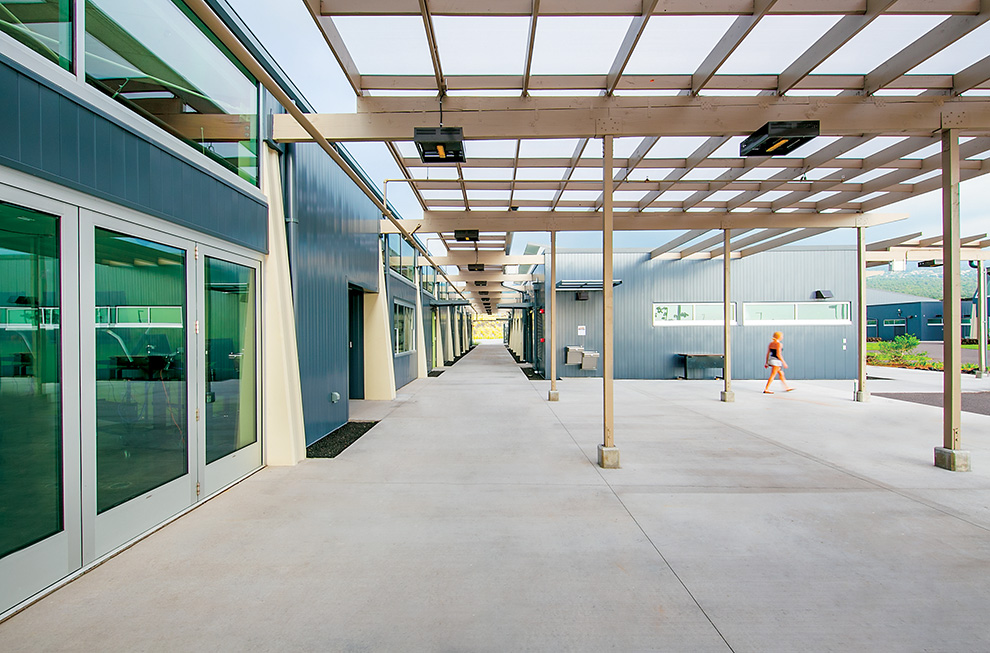
Attracting Students
Hidden from the highway and accessible via Kaiminani Drive, Pālamanui isn’t very visible to West Hawai‘i residents. Marty wants to change that by providing community outreach opportunities. A two-day open house, formatted as “A College Experience,” is planned March 21–22 when local schools are on spring break.
“In addition to high school students weighing their college options, part of the idea is for parents to bring their children, as a family, to see what we have here,” explains Dr. Fletcher. “We want to show off the campus when it’s acually functioning and let keiki (children) and their parents envision themselves as students here.”
The College Experience event will have families attend in two-hour blocks to experience a multiple classroom rotation through the campus. Attendees will witness first-hand how the campus works in action, showing both faculty and students interacting. The hope is the experience will open the conversation and the possibilities of attending Pālamanui to prospective students.
“Part of being sustainable is also servicing people in different ways,” emphasizes Dr. Fletcher. “People donʻt have to move to get an education here, which makes it so much more convenient and doable.”
Jason Roberson of Kailua-Kona credits the campus with allowing him to work towards an accounting degree without moving. While employed in construction as a granite fabricator, he wanted to pursue a degree and remain in Kailua-Kona, so he came to Pālamanui. He earned an Associate of Arts with a Business Emphasis in two years and then smoothly transferred to UH-West O‘ahu through the universityʻs Distance Learning Program. Now a junior, he plans to graduate with his accounting degree in Spring 2019—a four-year college experience.
“I love the campus; all the classrooms are well-lit without needing so much artifical lighting,” shares Jason. “The technology for video conferencing is huge.”

Distance Learning provides students with access to UHʻs statewide educational resources through a network of audio, video, and computer technologies. Testing for Distance Learning is conveniently done on-site at Pālamanui. Distance Learning options are available to earn undergraduate, post-baccalaureate and graduate certificates, plus associate, bachelor, master and doctoral degrees. Students can study a variety of disciplines including nursing, teaching, business administration, public administration, management, economics, social sciences and more.
“We want the community to know our state-of-the-art Pālalmanui is a landmark for higher education,” notes Dr. Fletcher. “Designed for 21st-century learning, it is a vibrant and essential resource for those who call West Hawai‘i home.” ❖
Photos by Andrew Richard Hara
For more information: hawaii.hawaii.edu/palamanui/
Mahalo Clark Realty Corp. – Sustainability Story Sponsor
